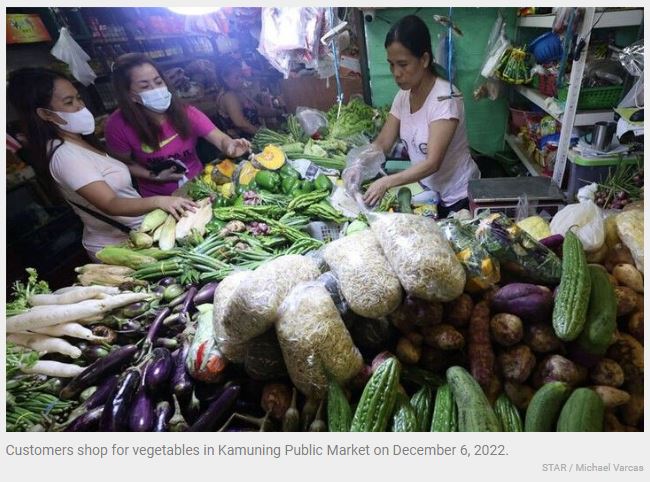Philippines: More BSP rate hikes loom as inflation spikes
MANILA, Philippines — Expect the Bangko Sentral ng Pilipinas (BSP) to deliver more rate hikes and bring the benchmark rate to at least six percent this year, as inflation soared above the government’s target last year, top bank economists said.
HSBC Global Private Banking and Wealth chief investment officer for Southeast Asia James Cheo said in an online press conference that core inflation in the Philippines is now the highest in the region.
This, Cheo said, would prompt the BSP’s Monetary Board to further raise key policy rates this year.
“The country’s core inflation is currently the highest in (the) region. With the balance of risk tilting toward inflation, we assess the BSP to make three consecutive 25 bps (basis points) rate hikes in 2023, pausing at 6.25 percent by second quarter of this year,” Cheo said.
The BSP hiked interest rates by 350 bps last year, bringing the overnight reverse repurchase rate to a 14-year high of 5.50 percent from an all-time low of two percent, to tame inflation and stabilize the peso.
To maintain a healthy interest rate differential, the Philippine central bank matched the aggressive rate hikes delivered by the US Federal Reserve.
“The BSP will then likely stay on hold for the rest of 2023 and perhaps at least until the second half of 2024,” Cheo said.
Data released by the Philippine Statistics Authority (PSA) showed inflation soared to a new 14-year high of 8.1 percent in December from eight percent in November.
This brought the average inflation to 5.8 percent in 2022 from 3.9 percent in 2021, well above the two to four percent target set by the BSP.
HSBC also sees the peso weakening further to 56.50 to $1 by the end of this year after slumping by 9.3 percent to close at 55.755 at end-2022 from 50.999 at end-2021. The local currency slumped by as much as 15.7 percent to hit an all-time low of 59 to $1 last October due to the hawkish stance of the US Fed.
“On the currency front, with the peaking of the US dollar strength, we think that US dollar-Philippine peso (rate) could reach 56.5 by the end of 2023,” Cheo said.
For his part, Bank of the Philippine Islands (BPI) lead economist Jun Neri sees the need for the BSP to further raise interest rates to at least six percent as soon as possible.
“With inflation still on an upward trend, the BSP may need to hike its policy rate further in the first half of the year. Recent indicators have shown that demand remains strong as consumers continue to engage in revenge spending, and there might be a need to temper this through rate hikes in order to guide inflation back to the preferred path,” Neri said.
Moreover, Neri pointed out that the hiking cycle of the US Fed has not ended and is expected to continue in the next two quarters.
According to Neri, the direction of interest rates could change in the second half of the year, depending on what the US Fed would do, as it could decide to take back some of their hikes and bring down the Fed funds rate closer to three percent if a recession in the US happens.
“In this scenario, the BSP policy rate might peak at around 6.5 percent in 2023. The BSP will likely deliver its own cuts following the Fed, but still maintaining the 100 to 200 bps differential with US rates. The BSP policy rate could go down to 4.75 percent in the latter part of 2023 if this happens,” Neri said.
ING Bank senior economist Nicholas Mapa said the “game changes once the US Fed finally pivots, as policy rates are currently in restrictive territory.”
“BSP (is) likely to hike rates to six percent then gauge (the) lagged impact of aggressive 2022 hikes,” Mapa said.
The ING economist said inflation likely peaked last month and could decelerate to below eight percent as early as the first quarter of 2023.
In a statement, the BSP said it remains prepared to take all monetary policy actions necessary to bring inflation back to a target-consistent path over the medium-term.
“The BSP also continues to support the timely implementation of non-monetary government measures to mitigate the impact of persistent supply-side pressures on inflation,” the central bank said.
Based on its latest assessment, the BSP Monetary Board raised its inflation forecast to 4.5 from 4.3 percent for this year, but lowered its projection to 2.8 from 3.1 percent for next year.
“The risks to the inflation outlook remain tilted to the upside for 2023, but are seen to be broadly balanced for 2024. Upside risks continue to dominate the inflation outlook up to 2023 while remaining broadly balanced in 2024,” it said.
According to the central bank, the expected upside risks to inflation over the policy horizon stem mainly from elevated international food prices due to high fertilizer prices and supply chain constraints.
On the domestic front, trade restrictions, increased prices of fruits and vegetables due to weather disturbances, higher sugar prices, pending petitions for transport fare hikes, as well as potential wage adjustments in 2023 could push inflation upwards.
Meanwhile, the BSP said the impact of a weaker-than-expected global economic recovery continues to be the primary downside risk to the outlook.
Source: https://www.philstar.com/business/2023/01/06/2235577/more-bsp-rate-hikes-loom-inflation-spikes


 English
English




